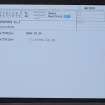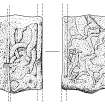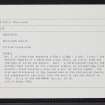Monifieth
Cross Slab (Pictish), Pictish Symbol Stone (Pictish)
Site Name Monifieth
Classification Cross Slab (Pictish), Pictish Symbol Stone (Pictish)
Alternative Name(s) Monifieth, St Regulus' Church
Canmore ID 33410
Site Number NO43SE 25.03
NGR NO 4953 3235
Datum OSGB36 - NGR
Permalink http://canmore.org.uk/site/33410
- Council Angus
- Parish Monifieth (Angus)
- Former Region Tayside
- Former District City Of Dundee
- Former County Angus
Monifieth 3 (St Regulus), Angus, cross-slab fragment
Measurements: H 0.46m, W 0.58m, D 0.08m
Stone type: grey sandstone
Place of discovery: NO 4953 3235
Present location: National Museums Scotland (X.IB. 28)
Evidence for discovery: found sometime before 1864 when a well was being dug in a garden in the village. It was given to NMAS in 1871.
Present condition: worn and damaged surfaces, and broken top and bottom.
Description
A central portion of a cross-slab, this fragment is carved on both broad faces. In relief on face A is the shaft of a cross, bordered by roll moulding and filled with dense circular interlace pattern. To the left of the shaft is a quadruped facing left, above a human figure with his knees drawn up and tightly interlaced with the legs of a large bird, which is biting the back of the man’s neck. To the right of the shaft are two interlaced serpents. On face C are incised a hunting scene with horseman, two hounds and a deer, all facing left, and another quadruped facing right, a fish-monster and two beasts with confronted jaws, possibly around a human head.
Date range: ninth or tenth century.
Primary references: Neish 1872, 73-4; ECMS pt 3, 230.
Desk-based information compiled by A Ritchie 2018
External Reference (1980)
NO43SE 25.3 4953 3235.
No. 3 A cross-slab measures 0.45m x 0.58m x 0.08m. Front - the defaced remains of a decorated cross shaft, on either side the vestiges of birds and beasts. Back - a horse-backed figure, the bottom right corner of the crescent symbol, an incised dog, fish monster, hound chasing a stag and a pair of biting heads. The slab was discovered in the foundations of the old parish church, and subsequently was built into the wall of the new church in 1812. It is in the RMS(NMAS) Acc.no. IB 28. Information from R Jones 1980.












